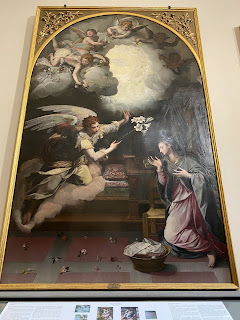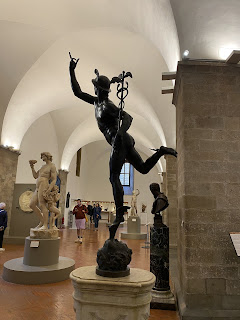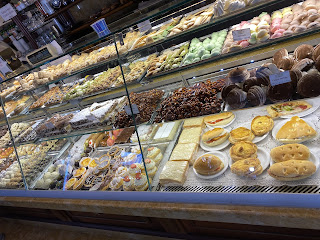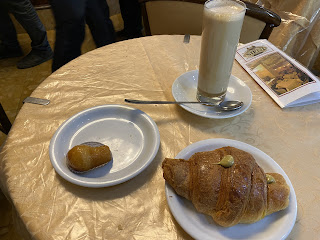Saturday was a whirlwind tour of museums - the Ufizzi, the Accademia, and the Bargello. There are many more in Florence and you could probably spend a whole week just going to them. Each of them has at least one extremely important work of art, which they base the rest of the collection around. Which also means that you can’t just go to one, but need to try to see as many as possible if you want to see the major works that are here in Florence. I also took a cooking class Saturday night on making gnocchi and sauce. Many of the sculptural pieces are down three long halls like this in the Ufizzi Museum. Of course pieces done by Michelangelo and other greats receive special treatment in other rooms, but there is a huge collection right here in the open galleries. And they are magnificent. I can honestly say that I didn’t take a picture of every single one of them, but I took a picture of more than I needed to. Sculpture fascinates me!
Here are a few:
The expressions that each sculpture puts into the facial features, then the cloaks that drape around them like real fabric, the hair styles that show each delicate lock, the details on hands and feet. All of it is amazing to me. Some sculptors even created different dimensions of body parts based on how the figure would be viewed, so that it looked more life-like. For example, hands might be larger than feet, but if the sculpture is seen from below, the hands would need to be exaggerated for them to look “normal”. It’s all quite fascinating to me.
Here is Octavian Augustus. The sculptor chose to go with the more youthful appearance of Octavian before his ascent to the throne, which aged him and made him quite stout during his reign.
Emperor Hadrian, who ruled from 117-138 AD. He was one of the first emperors to have beard, supposedly to hide a large wart on his chin.
Originally identified as Emperor Caligula, but upon further analysis this is more probably Agrippa Postumus, son of Marcus Agrippa and Julia, called such because he was born after his father’s death. Emperor Augustus adopted the young Agrippa to be his heir in 4 AD.
Venus and Mars, the goddess of love and the god of war.
Ceres, the goddess of fertility - shown here in her black cloak of marble following the death of her daughter, Proserpina, supposedly depicting the cycle of life and death. Her black cloak contrasts sharply with her white marble face, arms, hands and feet.
Julius Caesar. Again the mix of black and white marbles.
Emperor Antonius Pius. He ruled from 138-161 AD. He was one of the first (and perhaps only) emperor who cared about the prosperity of Rome and Italy as a whole, as well as the needs of orphans and of the lower classes. He was extremely popular among the people and with the Senate.
Emperor Marcus Aurelius, son of Antonius Pius. He ascended the throne with his brother, Lucius Verus, on the death of their father. He was also well known as a philosopher and sought to be much like his father, seeking to be just in leadership.
Emperor Marcus Agrippa, who ruled between 63-12BC. He was the right-hand man of the very first Roman Emperor, Augustus. He married Augustus’ daughter, Julia.
Nero is wearing the head of Medusa on this mantle.
Emperor Trajan, who ruled from 98-117AD, was the first to be born in the provinces. He was considered to be the best one, earning himself the nickname, Optimus Princeps, or Excellent Ruler. I love the mix of marbles and red onyx.
Empress Domitia, wife of Domitian. Her hairstyle, honeycombed and puffy, was unusual for the day and was copied by many women of her era.
Antonius, lover of the Emporer Hadrian, died mysteriously in the waters of the Nile.
Empress Helena, renowned for her “discovery” of the relic of the True Cross in Jerusalem. Very few sculptures depict Emperors or Empresses reclining.
Emperor Tiberius, adopted son of the Emperor Tiberius Claudius Nero. He ruled the Roman Empire for 23 years from Villa Jovis on the island of Capri.
Sorry, if I got carried away with the sculptures of these Roman men and women, mostly emperors and empresses. History and art, together, are quite powerful. I’ll try to keep the remaining ones few and far between.
Switching gears, here are a number of paintings of the Annunciation:
I think this is one of my favorites. By Matthias Stomer who trained under Gherardo delle Notti, but was a keen lover of Caravaggio’s style, which definitely comes through in this work.
By Allori
By Botticelli
By Giovanni del Biondo
By Neri di Bicci
A work done by the collaboration between Domenico di Zanobi and Filippo Lippi
By Botticelli
By Giotinno, also known as Tommaso Fiorentino
By Leonardo Da Vinci
This is a relief done by engraving raised stone by Donatello.
By Mariotto Albertinelli
Some interesting musical instruments from the Renaissance period:
An early harpsichord
On the left is a Double Bass - over 8 feet tall
An upright harpsichord
A pair of hardy-gurdies!
An Antonio Stradivari violin
Actually, I found these interesting instruments at an outside stand in Florence.
Various Piccolos, Flutes, Clarinets, and something called “the snake”. Can you figure out which one that is?
An oval spinet
I know you’ve been waiting to see some of the “biggies” from the various museums in Florence. Here they are:
The David, by Michelangelo, soaring 17 feet in the air. He used to hang-out outside the Palace, until a protestor threw a chair out the window and damaged his right arm.
Depicted in pop art, cards, tapestries, pillows, posters, plaques…you name it. The little angel playing the lute by Rosso Fiorentino. This piece of art is only a fragment of a larger altarpiece that no longer exists.
The Mercury Man, FTD’s logo, was made of bronze by a Flemish sculptor named Jean Boulogne, who went by Giovanni da Bologna or Giambologna. He spent most of his life working in Italy. This sculpture was commissioned by the Medici family to adorn their fountain at Villa Medici on top of the plume of water.
The Palestrina Pieta by Michelangelo (although there has been some recent speculation about whether he did this or not). Here, Christ is lovingly carried in death by Mary his mother and Mary Magdalene.
And - the Birth of Venus by Botticelli
I won’t bore you with more, but I’ve got about 1,000 more photos on my phone, if you’re interested. However, before leaving the works of the museums, I must share my own personal favorites. There are just two.
This is called, The Head of Old Man, by Camillo Boccaccino. Notes from those who study Art History believe that this painting was just a sketch for a figure in a more monumental piece. But, I love it the way it is. The deep set eyes, which you can barely see. The light that shines on his furrowed brow and white hair seems to then fade out into the background of the painting - a commentary on life, perhaps, as we get older?
Known as “The Lady of Sorrows”. This is an Italian painter’s copy of a work done previously by Flemish artist, Hans Memling. But there is something about this painting that draws me into her sorrows. She is stoic, serene, barely showing emotion and yet you see it in her eyes, especially when you notice the redness of the lids and the teardrops that fall from them.
Last of all - food pictures!
I’m not sure why the French get all the praise for pastries. Italian pastries and sweets are SO GOOD (and maybe better?) I chose this Treccia for my morning pastry on Saturday. This morning I chose this:
A croissant filled with Pistachio Cream and a Baba. If you’ve never had a Baba or even know what it is, you must look it up! It is beyond beyond. And you should never not be allowed to have them on a Sunday morning!
Don’t these look good! But, I wanted soup, so I had Pumpkin Cream Soup with Bacon.



Last night I had a cooking class on making gnocchi and sauce. It was hosted by Anna who is originally from Naples. She also lived for 6 years in the United States, first on the east coast in Philadelphia, New York and Boston, then on the west coast in Los Angeles and San Diego. She’s lived the last 10 years in Florence. She’s an artist by trade, combining a painted background with live natural elements in the foreground. However, she was trained in church art restoration work. So, we hit it off right away and spoke about my Sabbatical project: Breaking Bread with our Ancestors. She told me about cooking with her grandmother and that the recipe we were going to be cooking that night was her grandmother’s who had also encouraged her to go into her art profession. Her uncle is a priest in the Catholic Church. The only other guest was Melanie from Panama. She and her mom own a catering company. When she heard about my project, she mentioned that she was a Sunday School teacher back home and loved the idea of the connection we have between food and faith. She even spoke briefly about the many feasts/banquets mentioned in the Bible and why she loves to cook with her mom, catering to large groups of people. She said that it sometimes felt like the Lord’s feast, when all went well, when she and her mom prepared food without problems or incidents, when the people were all happy and excited and enjoyed it. We all laughed knowing that this was probably a rarer occasion than we’d like to admit.
Here’s us making dinner:

Tomorrow, I’m on the way to Siena, but before I go I’m going to check out the Central Market, not far from the train station.

























































No comments:
Post a Comment